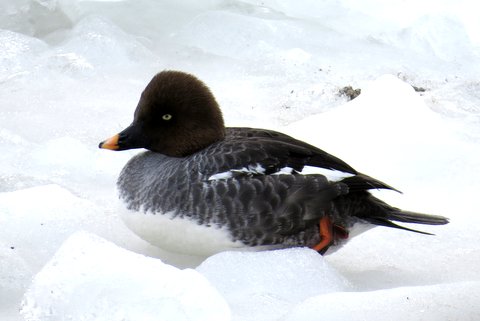Birding at Delta Park
An Important Bird Area Update
by Carl Runge
Important Bird Areas, or IBAs, are areas that provide essential habitat for one or more species of birds, either for breeding, wintering, or during migration. They are designated areas that stand out from the surrounding landscape and need to be protected to ensure a healthy avian population.
Green Heron
Photo: Judy Brook
The IBA Program was started in Europe by BirdLife International in the 1980s. The program has grown to include several thousand sites in 156 countries, and now encompasses millions of acres of habitat. The purposes of the program are to identify the areas of the world that are most important for maintaining bird populations, to monitor these areas for changes in bird population and habitat, and to effect long-term protection of these areas to optimize biodiversity.
IBAs in the United States and in Vermont
The United States partner of BirdLife International is the National Audubon Society, which began its IBA initiative in 1995. At least 40 state Audubon organizations have initiated IBA programs and over 1200 IBAs have been identified in the U.S.
Common Goldeneye
Photo: Judy Brook
Vermont was in the vanguard of state IBA programs. Audubon Vermont, primarily through its Conservation Director, Mark LaBarr, has already established 17 geographical IBAs and four IBA complexes. All areas have begun bird monitoring efforts. In the GMAS area (Chittenden, Franklin, and Grand Isle counties) there are currently seven IBAs and one IBA complex. In Northwestern Vermont the IBAs include Delta Park and Derway Island, the Missisquoi National Wildlife Refuge, Mud Creek Wildlife Management Area, Sandbar Wildlife Management Area, Young Island, the Franklin County Airport, and the Green Mountain Audubon Center and Birds of Vermont Museum properties in Huntington. The IBA complex includes the four Common Tern nesting islands in Lake Champlain.
The Delta Park IBA in Colchester
Black-bellied Plover at Delta Park
Photo: Clem Nilan
Delta Park, a 55-acre park owned and managed by the Winooski Valley Park District, is located at the mouth of the Winooski River in Colchester. Within the park are several habitat types including river bottom delta and associated wetlands, shoreline, and forested landscape. It has been chosen as an IBA because it is a historically important migration stopover for terns, shorebirds, waterfowl, and songbirds. While it is a protected area, it is surrounded by development and is bisected by the newly constructed Colchester Bikepath and bridge crossing to Burlington.
The WVPD has been monitoring the park for several years, concentrating on protecting turtle nesting grounds, a Vermont State threatened Tiger Beetle species, and several rare plant species including the Vermont State threatened Beach Pea.
Observations
In 2002, GMAS and WVPD began to monitor migrating birds. Notable observations included:
Ducks:
American Black
Mallard
Northern Shoveler
Bufflehead
Common Goldeneye
Hooded and Common Merganser
Shorebirds:
Greater Yellowlegs
Least and Pectoral Sandpiper
Dunlin
Wilson’s Snipe
Sanderling (seen unusually late in November)
Bonaparte’s Gulls (seen in large numbers)
Common Terns (seen occasionally)
Notable passerine migrants:
Great Crested Flycatcher
Ruby-crowned Kinglet
Blue-gray Gnatcatcher
Hermit Thrush (late October)
Marsh Wren
Northern Parula
Black-throated Green Warblers
Notable Spring migrants:
Pied-billed Grebe
Great Egret
Great Blue Heron
Black-crowned Night Heron
American Black Duck,
Mallard
Gadwall
Green-winged Teal
Scaup
Common Merganser
Spotted Sandpiper
Other passerine migrants:
Eastern Phoebe
Barn Swallow
Ruby-crowned Kinglet
Brown Thrasher
Cedar Waxwing
Yellow-rumped, Black-and-white, and Yellow Warblers
American Redstart
Northern Waterthrush
Common Yellowthroat
Scarlet Tanager
Savannah and Swamp Sparrows
In 2003, Mark LaBarr and Sherry Berrin (WVPD) established a MAPS (Monitoring Avian Productivity and Survivorship) program that included a banding station and habitat survey at the park. During the summer, confirmed evidence for nesting at the park was found for:
Wood Duck
Tree Swallow
Tufted Titmouse
Blue Jay
American Robin
Warbling Vireo
Brown-headed Cowbird
Baltimore Oriole
In addition, Allan Strong of UVM School of Natural Resources confirmed the following species breeding at the park in 2003:
Canada Goose
Virginia Rail
Sora
Killdeer
Red-eyed Vireo
Black-capped Chickadee
Northern Cardinal
Red-winged Blackbird
Common Grackle
American Goldfinch
A complete species list can be found by clicking the VT eBird link below.
Carl Runge is a former GMAS board member.
Resources


